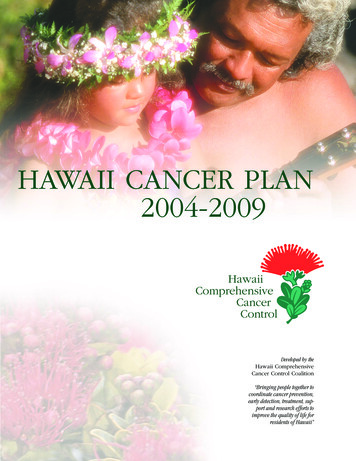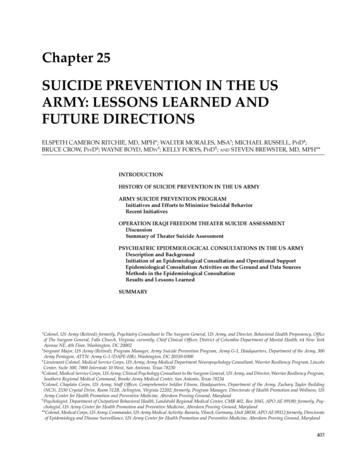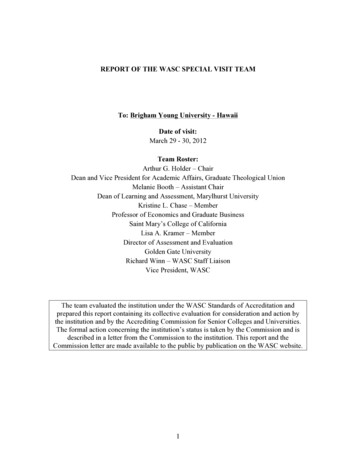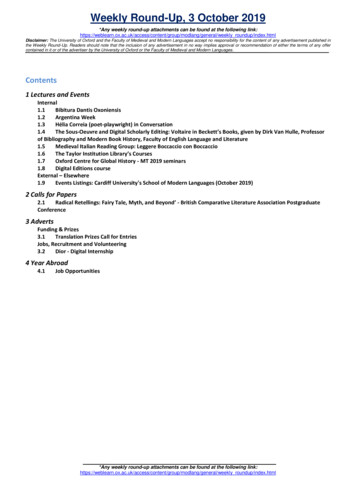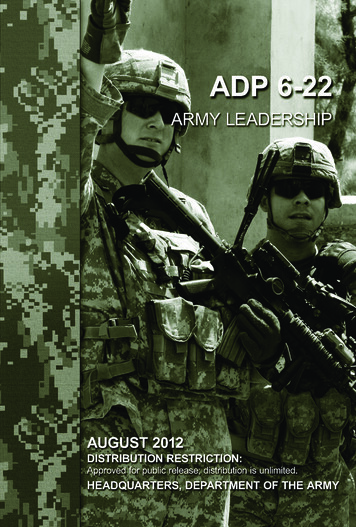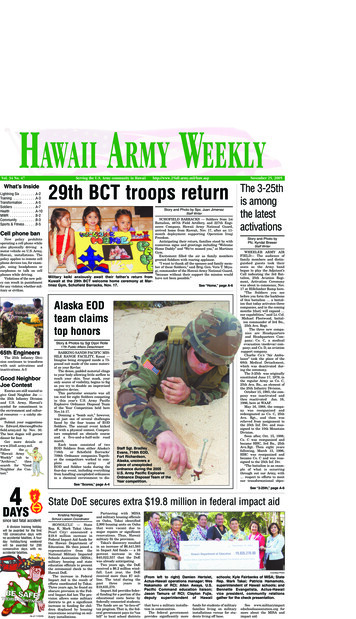
Transcription
HAWAII ARMY WEEKLYVol. 34 No. 47Serving the U.S. Army community in HawaiiWhat’s InsideLightning Six . . . . . . . .A-2Training . . . . . . . . . . . .A-3Transformation . . . . . . .A-5Soldiers . . . . . . . . . . . .A-7Health . . . . . . . . . . . . .A-10MWR . . . . . . . . . . . . . .B-2Community . . . . . . . . .B-3Sports & Fitness . . . . . .B-5Cell phone banNew policy prohibitsoperating a cell phone whilealso physically driving amotor vehicle on U.S. Army,Hawaii, installations. Thepolicy applies to remote cellphone devices too, for example, using headphones orearphones to talk on cellphones while driving.Violations of the new policy can result in punishmentfor any violator, whether military or civilian.http://www.25idl.army.mil/haw.aspNovember 25, 200529th BCT troops returnStory and Photo by Spc. Juan JimenezStaff WriterSCHOFIELD BARRACKS — Soldiers from 1stBattalion, 487th Field Artillery, and 227th Engineers Company, Hawaii Army National Guard,arrived home from Kuwait, Nov. 17, after an 11month deployment supporting Operation IraqiFreedom.Anticipating their return, families stood by withnumerous signs and greetings including “WelcomeHome Daddy” and “We’ve missed you,” at MartinezGym.Excitement filled the air as family membersgreeted Soldiers with roaring applause.“I want to thank all the spouses and family member of these Soldiers,” said Brig. Gen. Vern T. Miyagi, commander of the Hawaii Army National Guard,“because without their support the mission wouldMilitary keiki anxiously await their father’s return from have not been possible.”Kuwait at the 29th BCT welcome home ceremony at Martinez Gym, Schofield Barracks, Nov. 17.See “Home,” page A-6Alaska EODteam claimstop honorsStory & Photos by Sgt Dijon Rolle17th Public Affairs Detachment65th EngineersThe 25th Infantry Division continues to transformwith unit activations andinactivations. A-5Good NeighborJoe ContestEntries are still wanted togive Good Neighbor Joe —the 25th Infantry Divisionand U.S. Army, Hawaii’ssymbol for commitment tothe environment and cultural resources — a catchy slogan.Submit your suggestionsto Edward.Abersong@schofield.army.mil by Nov. 30.The best slogan will garnerdinner for four.Get more details atwww.25idl.army.mil.Followthe“Hawaii ArmyWeekly” tab to“Archives,”thensearch for “GoodNeighbor Joe Contest.”BARKING SANDS PACIFIC MISSILE RANGE FACILITY, Kauai —Imagine being strapped inside a 75pound suit made of the same material as your Kevlar.The dense, padded material clingsto your body allowing little airflow toreach your skin. Your mask, youronly source of visibility, begins to fogas you try to disable an improvisedexplosive device.This particular scenario was alltoo real for eight Soldiers competingin this year’s U.S. Army PacificExplosive Ordnance Disposal Teamof the Year Competition held hereNov.14-17.Donning a “bomb suit,” however,was just one of several challengesfaced by the four teams of EODSoldiers. The annual event kickedoff with a physical contest. Competitors completed an obstacle courseand a five-and-a-half-mile roadmarch.Each team consisted of twoEOD Soldiers from either Alaska’s716thor Schofield Barracks’709th Ordnance companies. Together the competitors worked to completeanarrayofEOD and Soldier tasks during thefour-day event, including everythingfrom handling unexploded ordnancesin a chemical environment to disSee “Scores,” page A-4Staff Sgt. BradleyEvans, 716th EOD,Fort Richardson,Alaska, uncovers apiece of unexplodedordnance during the 2005U.S. Army Pacific ExplosiveOrdnance Disposal Team of theYear competition.The 3-25this amongthe latestactivationsStory and Photo byPfc. Kyndal BrewerStaff WriterWHEELER ARMY AIRFIELD— The audience offamily members and distinguished guests took theirseats as the Army bandbegan to play the Adjutant’sCall indicating the 3rd Battalion, 25th Aviation Regiment, Activation Ceremonywas about to commence, Nov.17 at Hillclimber Ramp here.“The Soldiers you seebefore you form the backboneof this battalion a battalion that today activates threecompanies, and in the comingmonths [that] will expand our capabilities,” said Lt. Col.Michael Fleetwood, battalion commander of 3rd Bn.,25th Avn. Regt.The three new companies are Headquartersand Headquarters Company; Co. C, a medicalevacuation (medevac) company; and Co. D, an aviationsupport company.Charlie Co.’s “Air Ambulance” took the place of the68th Medical Detachment,which was deactivated during the ceremony.The 3-25th was originallyconstituted June 17, 1979, inthe regular Army as Co. C,25th Avn. Bn., an element ofthe 25th Infantry Division.October 15, 1985, the company was inactivated andthen reactivated Jan. 16,1986, here at WAAF.May 16, 1988, the company was reorganized andredesignated as Co. C, 25thAvn. Rgt., and then wasrelieved from assignment tothe 25th Inf. Div. and reassigned to the 10th MountainDivision.Soon after, Oct. 15, 1988,Co. C was reorganized andbecame HHC, 3rd Bn., 25thAvn.Rgt. Then eight yearsfollowing, March 15, 1996,HHC was reorganized andbecame Co. C and was reassigned to the 25th Inf. Div.“The battalion is an example of what is occurringthrough out our Army, with respect to efforts to meetour transformational objecSee “3-25th,” page A-64DAYSState DoE secures extra 19.8 million in federal impact aidKristina Noriegasince last fatal accidentA division training holidaywill be awarded for the first100 consecutive days withno accidental fatalities. A fourday holiday/long weekendwill be awarded for 200consecutive days with noaccidental fatalities.BE SAFE!TROPIC LIGHTNING!As of 11/23/05School Liaison CoordinatorHONOLULU — StateRep. K. Mark Takai (AieaPearl City) announced a 19.8 million increase inFederal Impact Aid funds forthe Hawaii Department ofEducation. He then joined arepresentative from theNational Military ImpactedSchools Association (MISA),military housing and stateeducation officials to presentthe ceremonial check to theHawaii DoE.The increase in FederalImpact Aid is the result ofefforts coordinated by Takai.Three years ago, he found anobscure provision in the Federal Impact Aid law. The provision allows some militarydistricts to get a significantincrease in funding for children displaced by housingrenovations occurring on military installations.Partnering with MISAand military housing officialson Oahu, Takai identified2,900 housing units on Oahuthat were vacant due tomajor repairs or significantrenovations. Thus, Hawaiimilitary fit the provision.Takai’s discovery resultedin an increase of 6,441,583in Impact Aid funds — a 16percent increase in the 40,022,557 that the DoEwas already anticipating.Two years ago, the DoEreceived a 6.2 million windfall. Last year, the DoEreceived more than 7 million. The total during thepastthreeyearsis 19,835,270.Impact Aid provides federal funding for a portion of theeducational costs borne byfederally connected students.The funds are an “in-lieu-of”tax program. That is, the federal government pays its “taxbill” to local school districtsCourtesy Photo(From left to right) Damien Hertslet,Actus-Hawaii operations manager; WesNakamoto of RCI; Allen Awaya, U.S.Pacific Command education liaison;Jason Tamura of RCI; Clayton Fujie,deputy superintendent of Hawaiithat have a military installation in communities.The federal governmentprovides significantly moreschools; Kyle Fairbanks of MISA; StateRep. Mark Takai; Patricia Hamamoto,superintendent of Hawaii schools; andBennette Evangelista, Actus-Hawaiivice president, community relationsgather for the check presentation.funds for students of militaryfamilies living on militaryinstallations versus for students living off base.See www.militaryimpactedschoolsassociation.org formore about the MISA andimpact aid.
NEWS & COMMENTARYA-2 Hawaii Army WeeklyWe want tohear from you.The Hawaii Army Weeklywelcomes articles from Armyorganizations, announcementsfrom the general public aboutcommunity events of interest tothe military community, and letters and commentaries.If you have newsworthyideas or stories you’d like towrite, coordinate with themanaging editor at 655-4816, ore-mail editor@hawaiiarmyweekly.com.The editorial deadline forarticles and announcements isthe Friday prior to Friday publications. Prior coordination ismandatory.Articles must be text or Wordfiles with complete information,no abbreviations; accompanying photographs must be digital,high resolution, jpeg files withcaptions and bylines.The Hawaii Army Weekly isan authorized newspaper and ispublished in the interest of theU.S. Army community in Hawaii.All editorial content of theHawaii Army Weekly is theresponsibility of the U.S. Army,Hawaii Public Affairs Office,Schofield Barracks, Hawaii96857. Contents of the HawaiiArmy Weekly are not necessarilythe official views of, or endorsedby, the U.S. Government or theDepartment of the Army.The Hawaii Army Weekly isprinted by The Honolulu Advertiser, a private firm in no wayconnected with the U.S. Government, under exclusive writtenagreement with the U.S. Army,Hawaii.The Hawaii Army Weekly ispublished weekly using the offsetmethod of reproduction and hasa printed circulation of 15,300.Everything advertised in thispublication shall be made available for purchase, use or patronage without regard to race, color,religion, sex, national origin, age,marital status, physical handicap,political affiliation, or any othernon-merit factor of the purchaser,user or patron.The appearance of advertising in this publication, includinginserts and supplements, doesnot constitute endorsement bythe Department of the Army, orThe Honolulu Advertiser, of thefirms, products or servicesadvertised.HAWAII ARMY WEEKLYCommanderMaj. Gen. Benjamin R. MixonPublic Affairs OfficerLt. Col. Mike DonnellyCommandInformation OfficerEd ing EditorAiko BrumAssistant EditorSgt. Sean KimmonsPhotojournalistsJoy BoisselleStaff Sgt. Manuel Torres-CortesSpc. Stephen ProctorSpc. Juan JimenezSpc. Amanda FlemettPfc. Nicole R. MontoyaPfc. Kyndal BrewerPfc. Durwood BlackmonLayoutLeah MayoAdvertising: 521-9111Editorial Office: 655-4816/8728Fax: 655-9290E-mail: Write the HAW ateditor@hawaiiarmyweekly.comAddress:Public Affairs OfficeBldg. 580, Stop 215Schofield Barracks, HI 96857Web Site:http://www.25idl.army.mil/haw.aspLightning Sixsends.Accidents mustbe prevented. Weall have a role.Two separate vehicleaccidents last weekend costthe lives of two of our Division Soldiers. Their deathscause many emotions andthoughts in our Army andour civilian communities.First and foremost, theseaccidents are a tragic loss oflife that affects families,friends, loved ones, andassociates. The Soldierskilled in these accidentshad families and friends,and everyone whom they Mixontouched will feel their loss.Our thoughts and prayers are with everyone who mournsas they cope with their shock and sorrow.But in addition to the grief, mourning, anger and disbelief brought about by these pointless deaths, many are asking why these accidents occurred and what can be done toprevent similar events from ever happening again. Asleaders, comrades in arms, mothers and fathers our firstquestion of ourselves must be, "What could I have done tosave their lives?" Each one of us has an implied task to takecare of one another -- in garrison and deployed.Because the investigations into these accidents are stillongoing, it is premature to draw any conclusions. However, I want to use this opportunity to discuss two of the leading causes of accidental death among our Soldiers: alcoholand speed.We all know the effect that alcohol has on our ability todrive. What we too often forget, however, is our obligationto our fellow Soldiers. In our small, tight-knit communityit is almost always the case that a fellow Soldier knowswhen a comrade is about to operate a vehicle under theinfluence of alcohol. All too often, this Soldier does notintervene to prevent his or her buddy from driving drunk.When this happens, it is unacceptable and inconsistentwith our core values -- stopping a fellow Soldier from driving after drinking is exactly how we demonstrate loyalty tothat brother or sister Soldier, duty to keep each other safe,respect for that Soldier, integrity in being the same leaderon and off duty, and personal courage to speak up and takeaction where others may perceive us as “uncool.”Soldiers simply do not let other Soldiers - or anyone else- drive after drinking alcohol!The next problem is driving at excessive speeds. Manyof our Soldiers, especially our younger Soldiers, commonlyoperate their vehicles at very high rates of speed. A safetyslogan tells us, "Speed that thrills is speed that kills." Butwhat are we -- what are YOU -- doing about it?In addition to my most profound sorrow for all the victims of these tragic accidents, I am also both upset and disappointed that these sad events could happen to membersof our Army family.Each of us must reflect on these accidents and theselosses and examine where we stand on the subjects of discipline, Army values, safety and whether we are committedto the bonds and traditions that make service to our nationa special calling and one that requires special commitment.Let each of us commit ourselves to doing everything inour power to prevent an accident of this nature from everdarkening our community again.Tropic Lightning!Benjamin R. MixonMajor General, U.S. Army CommandingMilitary hugs familiesIn November the military honors the extraordinary contributions of the nation’s military families, and Chairmanof the Joint Chiefs of Staff Gen. Peter Pace said, “the JointChiefs of Staff join me in thanking allmilitary families for their faithful serviceto their communities, their loved onesand this Nation.“You have faced the special challengesof long deployments, family separationsand frequent relocations with greatcourage and resolve,” he continued. “Indoing so, your selfless dedication hasdirectly contributed to the mission readiPaceness of our Soldiers, sailors, airmen,Marines, Coast Guardsmen and Merchant Marines.“My heartfelt thanks to the families who sacrifice somuch; you are patriots in a quiet, strong way and you makeall the difference.”November 25, 2005USARPAC speaks on safetyAs we cross into 2006, wecan take pride in the accomplishments and achievements of the past year as weprepare for the missions thatlie ahead.This holiday season, takethe opportunity to relaxand enjoy the company ofyour family and friends.Enjoy the holidays. You’veearned it.During this time, we needyou to make smart, informeddecisions. As an Army and aNation at war, we’re countingon each other to be therewhen called upon. We cannotafford to lose anyone to asenseless accident.Last year during the holiday season, the Army lost17 Soldiers to accidentaldeaths. Fortunately, theArmy in the Pacific wasfatality free. Leader involvement and Soldiers makings m a r t ,informeddecisionsmadeallthe difference.MotorvehicleaccidentsBrowncontinue tobethenumber one killer of our Soldiers outside of combat.Whether you are stationed inAlaska, Japan or Hawaii,driving can be challengingand dangerous.Never drink and drive,pay attention to the road conditions, obey the speed limit,use your safety equipment,and always wear your seatbelts and/or motorcycle helmets.This holiday season I askthat you make safety a personal priority. Make smartdecisions by not taking needless risks or engaging inreckless behavior.Take care of each other byshowing the courage andconcern to stop a friend or coworker from making a baddecision. I want you all tocome back safely.Thank you for your greatwork and sacrifices this year.I’m proud of all we’ve accomplished together.I wish you and your families a very joyful holiday season. Be Safe! Be Smart! OneTeam!John M. Brown IIILieutenant GeneralU.S. Army,Pacific CommandingThanksgiving is ‘a matter ofpersonal and national priority’Chaplain (Capt.) Clint Black2-11th Field Artillery ChaplainOn Sunday, Oct, 30, I stopped by the postexchange for some odds and ends. I noticedthe Halloween decorations were alreadydown and yep, you know what’s comingnext Christmas decorations were on theway up.As I reflected further, only 55 shoppingdays were left until Christmas.But whatever happened to Thanksgiving? And maybe more importantly, whatever happened to giving thanks?Did you know that President AbrahamLincoln’s ThanksgivingProclamationof 1863 established Thanksgiving as anational holiday on the last Thursday inNovember? Later, in 1939, PresidentFranklin D. Roosevelt changed the day tothe fourth Thursday in November, andCongress formally approved our current dayin 1941.Prior to Lincoln, various presidents,beginning with President George Washington, declared one day or another, usually inNovember, as a national “day of prayer andthanksgiving.” Washington first proclaimeda celebration Nov. 26, 1789.Of course, Thanksgiving has ties tothe Pilgrims as well. Though an officialdate is difficult to determine, in the fall of1621, on some day after the harvest,the first European settlers in Plymouth,Mass., shared a “thanksgiving meal”with their newfound Native Americanfriends.On different occasions after that, variouspeoples and groups (and even several earlycolonies and states) defined one particularday or another as a holiday set aside forthanksgiving.Interestingly enough, Christmas was notrecognized as a day of celebration in theUnited States until the mid-1800s. The griefbetween the early colonists and their European homelands led some of the earlycolonies to ban Christmas celebrations altogether.Yet, Thanksgiving was a uniquely American holiday, one that held deep significancefor the people of our land.You see, no matter the day, time orgroup, the generations before us were certain that thanksgiving, or giving thanks,was a matter of personal and national priority.So, why is it then that Thanksgiving, inthe sense of giving thanks, seems to be overlooked and even forgotten?Certainly, the answers to this questionabound. Yet I believe the reality of thisphenomenon points beyond what manymight write off as simply a “sign of thetimes.”To me, the act of “skipping Thanksgiving”(thank you, John Grisham) is indicative ofthe condition of our souls, both individuallyand collectively. Thanksgiving actuallyopens our eyes to see how others impact andimpart to our lives what we have not andcannot provide for ourselves.Skipping Thanksgiving is not only hazardous to our own souls, but to our nation aswell. When we no longer believe it necessaryto give thanks with any sincerity, when wemeasure our health, our families, our possessions and our abilities as merely extensions of our own strength and personalresources when we no longer recognizeany authority beyond ourselves or even ourfellow citizens, then we are truly more desperate than what we might have ever imagined.You see, to celebrate Thanksgiving rightis to know and celebrate the honest and sincere properties of giving thanks. These properties include the idea that one has receivedsomething beyond the scope or realm ofone’s own self, and that the giver of thatsomething is truly worthy and even “ought”to be thanked.So why not this year, during the four-dayholiday we know as Thanksgiving — surrounding the food, football and otherfestivities — take some time and reflect onwhat you have for which you should bethankful?Additionally, when you remember allthose blessings, why not think about whomyou have to thank for them? Whom mightyou thank for your job, your home, your possessions, your health, your family, yourspouse?Maybe you could thank your parents,your spouse, your children, Uncle Sam,your friends, the clerk in the store, yourNCO, your OIC or maybe you shouldacknowledge and honor God, to thank andpraise God with your lips and with yourlives.Why not take this holiday weekend asan opportunity to tell God and others“Thanks.”Voices of Lightning: What is the best thing about living in America?“.The ability to change certain socialand economic hardships.”Spc. Katie SmithCo. A , 325th BSBAutomated LogisticsSpecialist“.Freedom we have to be an American. We have it all thanks to themilitary.”“.Freedom to express yourself andto have dreams and live out thosedreams.”“.Options to do more. And we havemore economic and educationopportunities.”“.Being free.”Anothony AldereteRetireeCarolyn GreenWaialua Elementary SchoolPreschool TeacherCWO-2 Ari Jean BaptisteCo. C, 1st Bn., 25th Avn.Scout AviatorJames Thomas CovellRetiree
TRAININGNovember 25, 2005Hawaii Army Weekly A-33rd Brigade leaders hone Gracie combativeStory and Photo bySpc. Leslie Alberts3rd Brigade,Public Affairs OfficeSCHOFIELD BARRACKS —Sweat poured from Soldiersmethodically rehearsing theirescape from headlocks. They twisted into handcuffing positions andrestrained each other into submission. Yet, their environment waseerily quiet, and their mooduniquely intense.During a two-week period, 80select officers and senior noncommissioned officers squared-offto learn and perfect ground fightingtechniques under the measuredeye of their instructor, RorionGracie. These Soldiers appreciatedthe importance and significanceof a training opportunity unlikeany these leaders had everreceived.Gracie is one of the world’s premier self-defense and martial artsexperts. He trained Soldiers at 3rdBrigade’s Headquarters and Headquarters Company in “F” Quad,Oct. 17 to 28.The Gracie Combative is a specialized self-defense program. Itrecognizes realistic battle scenariosin urban environments where Soldiers may need to handle violentsuspects like enemy prisoners ofwar (EPWs) at close range, especially when the fight goes to theground, explained Gracie, founderof Gracie Academy.Gracie’s unique form of Brazilian Jiu-Jitsu already serves as thefoundation for the Army’s combatives manual.“The essence of this particularprogram is a trainer-to-trainer program,” said Gracie. “The intentionis to give these Soldiers a limitedamount of techniques that are basicenough for them to teach the nextlevel of Soldier. The goal is to giveSoldiers enough confidence to handle a confrontation with someonewho does not know what is goingon, like an unruly EPW,” Graciecontinued.“The very first day I tell the Soldiers two things: First, we have topractice from the perspective thatyour potential enemy is bigger,heavier and stronger than you sothat whateveryou do cannotrelyonstrength orspeed. Second,there is no suchfive-to-six techniques each dayand then reviewed those techniques the following day for fourdays.Thetechniquesranged from standingdefenses,grounddefens-teaching. Our goal isto establish a consistent teachingmethod amongthe Soldiers,” headded.Above — Sgt. Matthew Green, 2nd Battalion, 35th Infantry Regiment(top), and 1st Lt. Kite Faulkner, 2nd Bn., 27th Inf. Rgt., don’t hold anything back during a combatives tournament.Left —Soldiers perfect their ground fighting techniques.thing as a bad student. Whetherthe student learns is dependent onthe teacher,” he added.The Gracie Combative wastaught in two groups of 40 Soldiers.Each course spanned five days.Gracie, with the assistance ofhis two sons, Ralek and Ryron —both world-class martial artistsin their own right — introducedes, handcuffing and numerous submission tactics. The final dayinvolved application of all the techniques in a “round-robin” groundfighting tournament.“Repetition is crucial,” explainedGracie. “The Soldiers learn certaintechniques and how to teach thetechniques. A big problem is thelack of consistency on the method ofGracie’s approach was wellreceived.“He broke it down in a way thatit was impossible not to learn,” saidStaff Sgt. Gerald Mark, Headquarters and Headquarters Company,3rd IBCT. “The repetition with eachexercise made it so it becameingrained. Now, I can take histeaching philosophy that I learnedand incorporate it into training mySoldiers,” Mark added.“I currently teach combatives tomy unit and, as a result of thistraining, I am going to rethinkand teach differently,” said StaffSgt William Dunn, Alpha Company, 1st Battalion, 14thInfantry Regiment. “I amamazed at some of the techniques I learned here thisweek.“For example, with the‘rear-naked choke’ wealways used two arms.These guys taught ushow to use one arm,”Dunn emphasized. “Now,I can submit someoneand still hold my weaponwith my free arm. Sothis training is not onlyvaluable, but practical.”Sgt. 1st Class BrianK. Burgan, HHC, 3rdIBCT, and a former drillsergeant who taughtPhase 1 combatives toSoldiers during basictraining,similarlyobserved that Gracietrainingisimportant“because if someone has nobackground in fighting, it givesthem a basis of combatives thatthey can use besides what theylearned in basic training oradvanced individual training.” .“Many people are afraid to grapple because of the mindset that ifsomeone is bigger than me they aregoing to beat me. That is just nottrue with the techniques that Gracie teaches,” said Burgan.Burgan cautioned that “youmust continually practice this stuff.It is perishable. To keep on ourgame, we [leaders] need to be continually instructing our Soldiers,”he said.Rorion Gracie answered a life calling to teach jiu jitsuStory and Photo bySpc. Leslie Alberts3rd Brigade, Public Affairs OfficeSCHOFIELD BARRACKS — At18 years old, he found himself onthe streets of Waikiki, in betweenpaychecks, begging for sparechange.Thirty-five years later, he wasback on Oahu, this time doing whathe was “called” to do — teachingelements of his first love, BrazilianJiu Jitsu, to Schofield Soldiers whowere practically begging for histime and an autograph.At 53, Rorion Gracie is a worldrenowned martial artist, selfdefense expert and Jiu Jitsuteacher extraordinaire. At 6-feet-2inches tall, 175 pounds, it is difficult to imagine that this is the manwho was once considered the best“no-holds barred” fighter in theworld, the man who developed thetremendously successful UltimateFighting Championship in 1993.He is far from imposing, far frommenacing and far from intimidating, which are qualities that suchdistinctions conjure up in the imagination. However, what he is, is thebest Jiu Jitsu teacher in the world.Rorion Gracie (left) and his sonRalek Gracie, instructors for3rd IBCT’s Gracie Combatives,take a moment from training topose for a photo.Gracie has introduced groundfighting into nearly every majormartial arts, military unit and lawenforcement organization world-wide. And he does it because it iswhat he was “called” to do.“My family has been teachingJiu Jitsu for over 70 years inBrazil,” explained Gracie. “However, in my visits to the United Statesin the 70s, I realized that no onewas teaching it. There was nothinggoing on here.“There were other forms of martial arts, but no Jiu Jitsu, and Iknew that my family’s style waslight years ahead of other trades.No one was addressing groundfighting,” he continued.“I have a lot of faith that thingshappen for a reason. I have learnedthat God did not put me on thisearth to not be productive. I amconvinced that my reason is toteach, so one way or the other, Iknew I needed to present Jiu Jitsuand make it so exciting that peoplewould want to learn it,” he said.“So in 1978, I landed in NewYork with 2,000 in my pocket anda plan to make my family’s JiuJitsu popular worldwide.”Gracie began implementing hisplan in Torrance, Calif., a shorttime later.“I was cleaning houses in LosAngeles and, through contacts, thatled to doing ‘extra’ work in manypopular television shows of the1980s,” Gracie explained. “In themeantime, I put some mats in mygarage, and everyone I met, I invited to my home for a free Jiu Jitsuclass.“They would get hooked, a private class for 10. So I told thosefirst students that if you want afree class bring me a friend. If youwant five free classes, bring me fivefriends. So, I began marketing myJiu Jitsu and teaching out of mygarage.“Eventually, I was teaching lotsof Torrance, California, cops in mygarage. At one point, I had 130 students coming to my garage, sevendays a week with 80 people on awaiting list. That’s when I openedup the Gracie Academy in Torrancein 1989,” he explained.Ultimately, word of Gracie’stechniques spread and he foundhimself in touch with the U.S. ArmyRangers.“Two special operations guyscontacted me and wanted to take aclass. So these two guys came toCalifornia and spent eight hourstraining with me. Six months later,they called and said they hadchecked my background, and theywanted me to come to Fort Bragg toteach a class,” he explained. “Thatwas in and around 1994, 1995.“If it is good enough forRangers,” Gracie said, “I suppose itwas good enough for everyone elsein the military,” he said.And good enough it was. Today,Gracie Jiu Jitsu fundamentalsserve as the foundation for theArmy’s combatives manual. EverySoldier today learns elements ofGracie ground fighting techniquesin basic training.“My father has been training for50 years,” said Gracie’s son, 23year-old Rylon Gracie. “No one hasthe knowledge that he possesses. Iadmire him for all his mentoringand ability to teach this better thananyone in the world. I emulate him,and I only hope to be as healthy ashe is when I am his age,” he added.“I consider myself extremely fortunate to be in a position to help somany people,” said the elder Gracie.“It’s a blessing to be able to teachother people to defend themselvesand [to] help people be confident.My work impacts people in waysthat you cannot imagine. My worksaves lives.”
TRAININGA-4 Hawaii Army WeeklyNovember 25, 2005Engineers ‘go hot’ preparing to deploy to IraqStory and Photos byPfc. Durwood BlackmonStaff WriterSCHOFIELD BARRACKS —With the turn of a key, exhaustsmoke bellowed from beneath agrizzly five-ton truck. Soldiers fromCompany B, 84th Engineer Battalion, climbed aboard this metalbeast, and its Humvee counterparts, for a day of combat trainingand convoy live-fire exercises attraining Area X, Nov 17.This particular exercise wasdesigned to enhance combat efficiency while dealing with varyingenvironmental dangers.Soldiers from Co. A, 1
The Hawaii Army Weekly is an authorized newspaper and is published in the interest of the U.S. Army community in Hawaii. All editorial content of the Hawaii Army Weekly is the responsibility of the U.S. Army, Hawaii Public Affairs Office, Schofield Barracks, Hawaii 96857. Contents of the Hawaii Army Weekly are not necessarily the official views .

